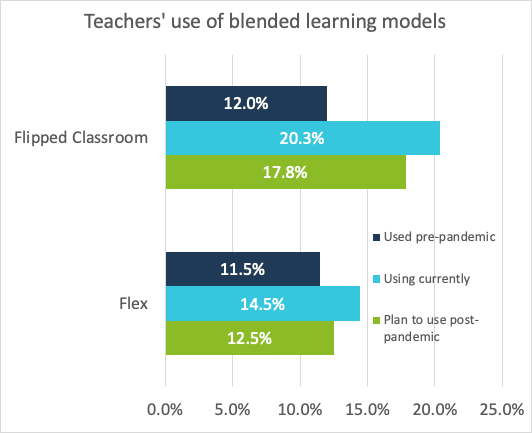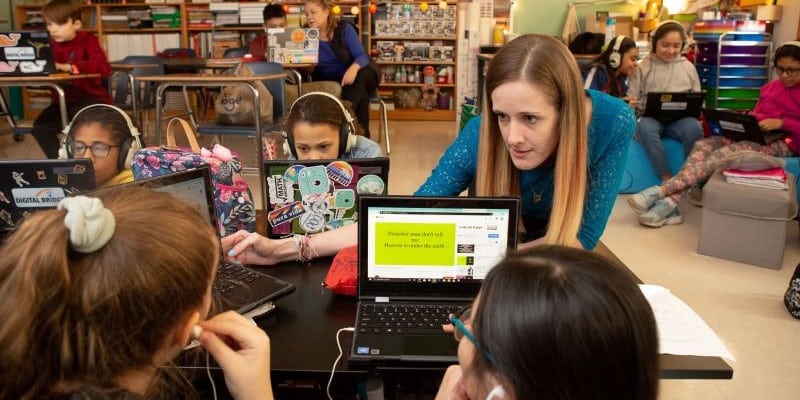Soon after the start of the school year, I read a press release from a school district in Alabama announcing to its community that due to rising COVID cases, school buildings would close for remote learning for two weeks, then begin blended learning for the remainder of the semester. The blended learning schedule would involve some students attending school on Mondays and Tuesdays, and others on Thursdays and Fridays, with Wednesday reserved for remediation, intervention, and additional support.
Announcements like this continue to be common in another school year marked by pandemic-related turmoil. In this case, and because I’ve studied blended learning for the last eight years at the Christensen Institute, the district’s use of the term “blended learning” caught my attention. On the one hand, given my research showing how blended learning can enable more student-centered instructional approaches, I should be pleased that the concept has become so mainstream. For instance, Google searches for the term, which have been growing steadily (but slowly) for years now, suddenly doubled within six months after the pandemic hit. By that measure, the answer to “Whatever happened to blended learning?” is: it’s exploding!
But unfortunately, in many cases, the now-mainstream term describes the wrong phenomenon. Here’s what I mean by that, and why it matters.
What’s blended and what’s not
Let’s dissect the landscape of COVID-era learning models to uncover where inaccurate understandings of blended learning come from. Blended learning means students experience online learning that is integrated with instruction at a brick-and-mortar location. But there’s more to the definition of blended learning than just a mix of online and in-person learning. In blended learning, students’ online learning experiences offer them some element of control over the time, place, path, or pace of their learning. That means students may do their online learning at home or at any other place that’s convenient and comfortable for them. It means they might choose for themselves what content or assignments to focus on and when. And it means that the pace of student learning might be variable, allowing students to speed through content that comes quickly to them, or slow down when they need to.
Last year, many schools coped with the pandemic using hybrid learning arrangements—where students receive some instruction in person with teachers and classmates and some instruction remotely. Because hybrid learning and blended learning both involve online learning and brick-and-mortar locations, hybrid learning boosted the prevalence of the term blended learning. But data from our recent national survey shows that most models for schooling last year failed the test when it comes to key hallmarks of blended learning: student control over time, place, path, and pace of learning. That’s because most teachers in our study reported a version of hybrid learning that we’ve called “concurrent,” or that many colloquially refer to as “Zoom-in-room.” In these hybrid arrangements, teachers deliver instruction and assignments to students in a classroom and students at home at the same time. Basically, concurrent hybrid instruction only uses online learning as a way to transmit conventional in-person instruction over the internet.
Recasting today’s hybrid learning arrangements as tomorrow’s blended classrooms
Despite the lack of flexibility in concurrent hybrid arrangements, there are several ways that today’s pandemic learning could evolve into student-centered, blended learning classrooms in the future.
First, increased tech infrastructure and confidence with online learning resources (like learning management systems, online lesson creation tools, and video recording) put certain blended learning models within reach. For example, after a teacher has learned to create online lessons, the teacher could then allow students to watch these lessons outside of school at any time or place, and allot in-person class time to activities like applying new concepts, collaborating in small groups, and small-group instruction. This blended model of instruction, in which students receive online learning assignments that cover class content for homework and in-person instruction for discussions and collaborative projects, is called a Flipped Classroom.
Second, we learned in our recent survey that some classrooms and schools that did implement blended learning during the pandemic expect to keep it going after COVID ends. For example, roughly 20% of teachers reported using the Flipped Classroom model during the pandemic (up from 12% pre-pandemic), and nearly 18% plan to keep using it post-pandemic. Similarly, teachers’ adoption of the Flex model, where online learning is the backbone of instruction and allows students to work through course content following individualized pacing and pathways, jumped from roughly 11% to 14% during the pandemic and is projected to settle out at just over 12% once the pandemic ends.

Third, it’s becoming increasingly clear that virtual schooling options are here to stay—perhaps not for a majority of families, but for a vocal minority who learned they prefer these arrangements. Among surveyed administrators, 32% said their school systems plan to offer virtual schooling post-pandemic—up from just 11% pre-pandemic. Virtual schooling isn’t a good fit for all students; many need in-person support and socialization opportunities that are harder to provide in purely virtual arrangements. Furthermore, many families rely on in-person schooling for custodial care for their children during the work day. But school systems that combine virtual schooling with in-person learning opportunities to create Enriched Virtual blended learning programs (perhaps by pairing virtual schools with learning hubs) offer their students the best of both in-person support and a high degree of flexibility.
Candidly, many families, teachers, and school leaders may feel overwhelmed and frustrated with the idea of trying new models and instructional design iterations right now. For most schools, educators, and students, the practical approach will be to shore up tried and true conventional practices as much as possible. However, school systems and educators that can find space to foster blended learning innovations now will be laying the groundwork for innovative, flexible, individualized learning experiences for more and more of their students in the years to come.
Photo by Allison Shelley for EDUimages.


